In the not-so-distant past, the term “automation” conjured up images of robots replacing factory workers or lines of code magically writing themselves. It sounded like science fiction or the plot of a futuristic thriller. Fast-forward to today, and automation has become a pervasive force, subtly and sometimes aggressively reshaping every facet of the tech industry, from how we write and deploy software to how businesses operate, scale, and compete.

For software developers, AI and ML engineers, and code enthusiasts across Africa, this sweeping change presents both a challenge and an enormous opportunity. On one hand, automation threatens to displace routine tasks and commoditize certain skills. On the other, it opens doors for innovation, increased efficiency, and the chance to focus on higher-level problem-solving, if you’re prepared.
Africa’s tech ecosystem is witnessing remarkable growth. Tech hubs are springing up in cities like Lagos, Nairobi, Accra, Kigali, and Cape Town, birthing startups, nurturing innovation, and attracting global attention. Yet, as automation technologies mature, there’s a growing urgency for tech professionals, tech enthusiasts, and even tech newbies across the continent to not only keep pace with global trends but to lead local adaptation.
The real question isn’t whether automation will affect your career because it absolutely will. The question is: how do you position yourself to benefit from it rather than be sidelined by it? How do you evolve with automation instead of becoming obsolete?
This comprehensive, constructive, and slightly humorous guide explores concrete, practical steps to stay ahead of automation. It will help you navigate this new landscape, build future-proof skills, and remain indispensable in a world where automation is no longer coming, it’s already here.
Understanding Automation’s Impact on Africa’s Tech Scene
Before diving into specific strategies, it’s essential to understand how automation is already influencing and in some cases disrupting Africa’s tech industry. From the bustling innovation hubs in Nairobi and Lagos to emerging tech corridors in Kigali and Addis Ababa, automation is gradually weaving itself into the fabric of daily operations, product development, and service delivery.
The truth is, no matter where you are on the continent, automation is not a distant Western phenomenon. It’s here. It’s being piloted in banks, embedded in mobile apps, adopted in logistics platforms, and even creeping into sectors like agriculture and health. The pace of adoption varies, yes, but the trajectory is undeniable.

Let’s break down some of the key areas where automation is making its mark:
- Robotic Process Automation (RPA)
RPA is revolutionizing how businesses handle repetitive, rule-based tasks. Think invoicing, payroll processing, customer onboarding, and even basic data entry, all done swiftly and with minimal error. In more developed economies, this shift has freed up time and resources for higher-value tasks. In Africa, however, RPA adoption is still in its early stages.
Why? The primary hurdle is not enthusiasm or demand — it’s the skills gap. Many organizations want to automate but lack personnel trained in RPA tools like UiPath or Automation Anywhere. This gap presents a massive opportunity for tech professionals, especially developers and engineers, to upskill and offer much-needed expertise. Upskilling isn’t just about job security anymore, it’s about seizing a competitive edge in a growing market.
- Artificial Intelligence (AI) and Machine Learning (ML)
AI and ML are no longer buzzwords reserved for researchers or Silicon Valley. They’re actively transforming how African companies approach data analysis, customer engagement, fraud detection, and personalization. From fintech apps predicting user behavior to logistics firms optimizing delivery routes, the applications are real and rapidly expanding.
For tech professionals across the continent, this means one thing: adapt or fall behind. The demand for machine learning engineers, data scientists, and AI-savvy developers is climbing, and those who understand not only the theory but the practical implementation of these systems are becoming indispensable assets. Whether you’re writing Python scripts or designing neural networks, now is the time to lean into AI and ML, not shy away from them.
- Infrastructure Challenges
Of course, it’s not all smooth sailing. Despite the enormous potential of automation, some very real infrastructure challenges continue to slow progress across parts of Africa. Unreliable power supply, inconsistent internet connectivity, and limited access to cloud computing platforms can make deploying and maintaining automated systems frustrating, if not impossible in certain regions.
These challenges aren’t just technical; they’re systemic. Solving them requires collaboration between governments, private sector players, and regional tech communities. Still, the entrepreneurial spirit that defines Africa’s tech ecosystem means that innovators often find clever workarounds, using offline-first applications, solar power solutions, or hybrid cloud deployments.
Understanding these dynamics is critical. Whether you’re a tech newbie trying to find your footing, a seasoned software developer looking to specialize, or an AI engineer seeking to stay relevant, recognizing the current landscape allows you to better position yourself for the future. Automation is shaping Africa’s tech scene and those who understand its patterns will shape its direction.
Step 1: Embrace Continuous Learning and Upskilling
In the fast-paced world of tech, standing still is equivalent to falling behind, especially in an era dominated by automation. Whether you’re a fresh-faced tech newbie writing your first line of code or a senior developer juggling microservices and machine learning models, one principle remains non-negotiable: continuous learning is paramount.

Automation doesn’t just change how things are done, it changes what needs to be done. The languages, frameworks, and tools that were in demand two years ago may now be obsolete, or worse, fully automated. Staying relevant means staying informed. And staying informed means investing in upskilling consistently and strategically.
Where to Learn: Practical Options for African Developers
Thankfully, you don’t need to empty your wallet or fly abroad to stay current. There’s a wealth of online platforms and resources designed to bring world-class education right to your smartphone or laptop.
Here’s a curated list of platforms ideal for tech professionals in Africa:
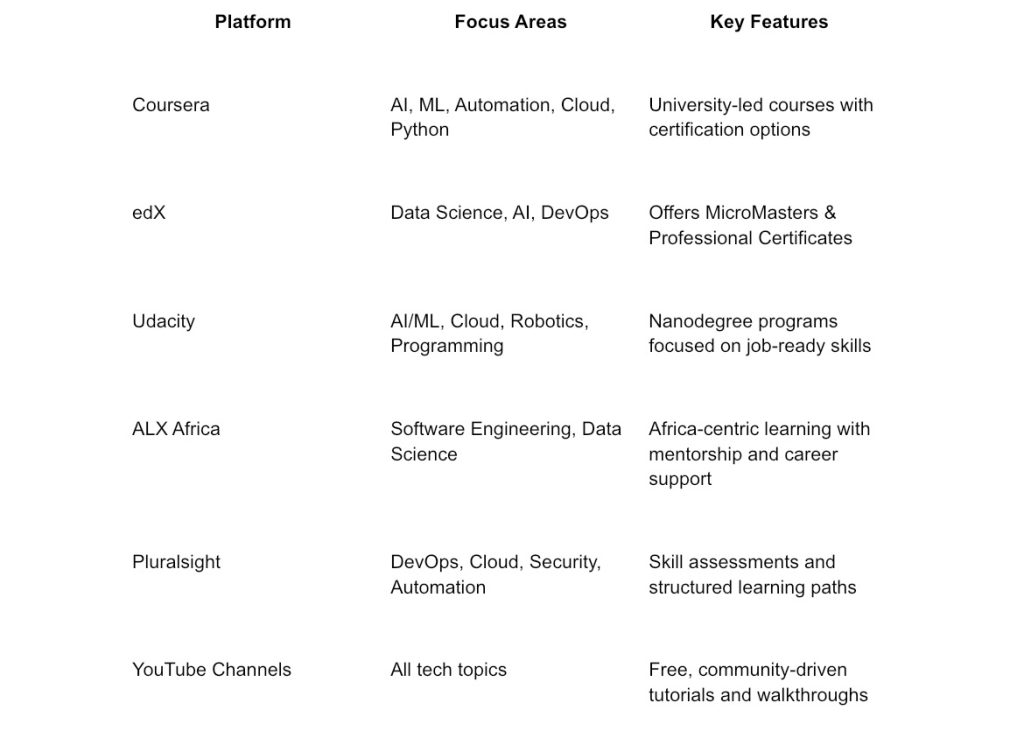
Additionally, tech communities across the continent regularly host free webinars, virtual hackathons, and in-person meetups, all great opportunities to learn, network, and stay plugged into current trends. Don’t underestimate the value of local bootcamps and developer groups in cities like Accra, Kampala, and Johannesburg, sometimes the most practical learning is peer-driven and community-based.
Certifications: A Smart Investment
If you’re looking to boost your credibility and stand out on job boards or freelance platforms, consider investing in a few key certifications. While a certificate won’t magically make you a master of automation, it does signal to employers and clients that you’re serious about your craft and up-to-date with industry standards.
Some highly respected certifications include:
- Google Professional Machine Learning Engineer
- AWS Certified DevOps Engineer
- Microsoft Certified: Azure AI Engineer Associate
- UiPath RPA Developer Certification
- IBM Data Science Professional Certificate
- Certified Kubernetes Administrator (CKA)
And if you’re on a budget? Start with free certification programs and courses offered by companies like IBM, Google, and Microsoft on platforms like Coursera and edX. These credentials are globally recognized and can provide a solid foundation in automation technologies.
Step 2: Master Automation Tools and Frameworks
Now that you’ve committed to continuous learning (and hopefully resisted the temptation to hoard certifications like Pokémon cards), it’s time to get practical. Staying ahead of automation doesn’t just mean understanding the theory, it means rolling up your sleeves and getting hands-on with the tools that are driving this revolution.
For tech professionals in Africa, whether you’re a seasoned software developer, an up-and-coming AI/ML engineer, or a determined tech enthusiast knowing which tools to master and how to use them effectively is the real game changer.

Why? Because in the world of automation, tools do the heavy lifting. But the ability to wield those tools strategically? That’s what separates the replaceable from the irreplaceable.
Below are some of the most impactful categories of automation tools and frameworks you should be adding to your arsenal.
1. Continuous Integration and Continuous Deployment (CI/CD)
CI/CD isn’t just trendy jargon thrown around in DevOps meetings, it’s the heartbeat of modern software delivery. If your development workflow still involves manually copying files into production servers, well… we need to talk.
These tools automate the process of building, testing, and deploying code, reducing human error and enabling developers to ship faster, safer, and more reliably.
Top Tools to Learn:
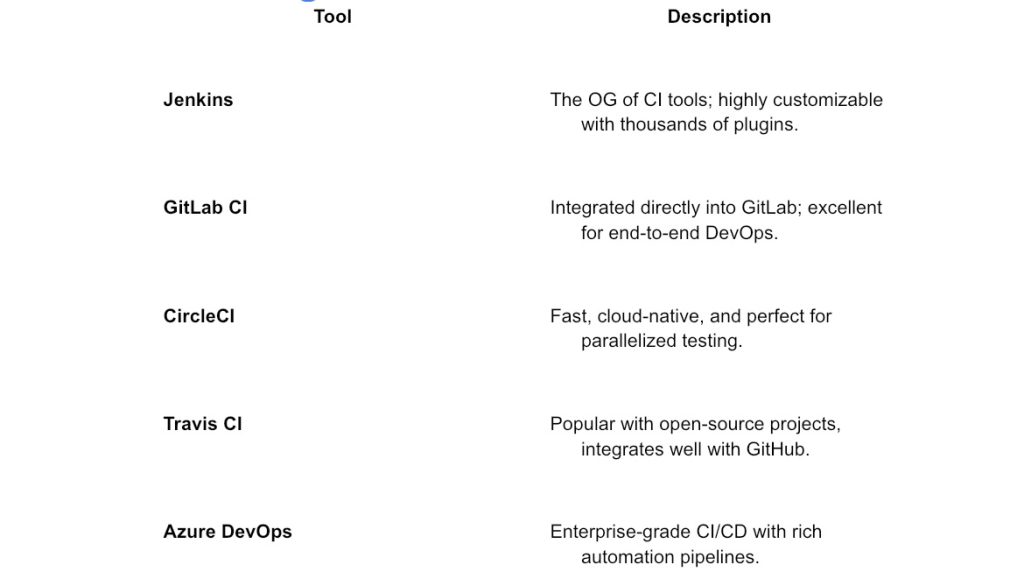
How This Helps You Stay Ahead of Automation:
Mastering CI/CD makes you invaluable on any modern dev team. Companies want people who understand how to keep the wheels turning even while everyone else is sleeping. Automating builds and deployments isn’t just cool — it’s expected.
2. Test-Driven Development (TDD)
While some developers swear by TDD and others swear at it, the benefits of Test-Driven Development are hard to ignore. Writing tests before writing code may feel awkward at first, but it can vastly improve code quality, catch bugs early, and streamline collaboration across teams.
TDD is the unsung hero of automation — the invisible backbone that allows CI/CD pipelines to thrive. Without reliable tests, automated builds and deployments are like riding a bicycle with no brakes.
Key Concepts to Understand:
- Unit Testing: Verifying individual pieces of logic.
- Integration Testing: Ensuring different parts of the system work together.
- Mocking & Stubbing: Simulating data sources, APIs, or external services.
- Code Coverage: Measuring how much of your code is being tested.
Popular TDD Frameworks:
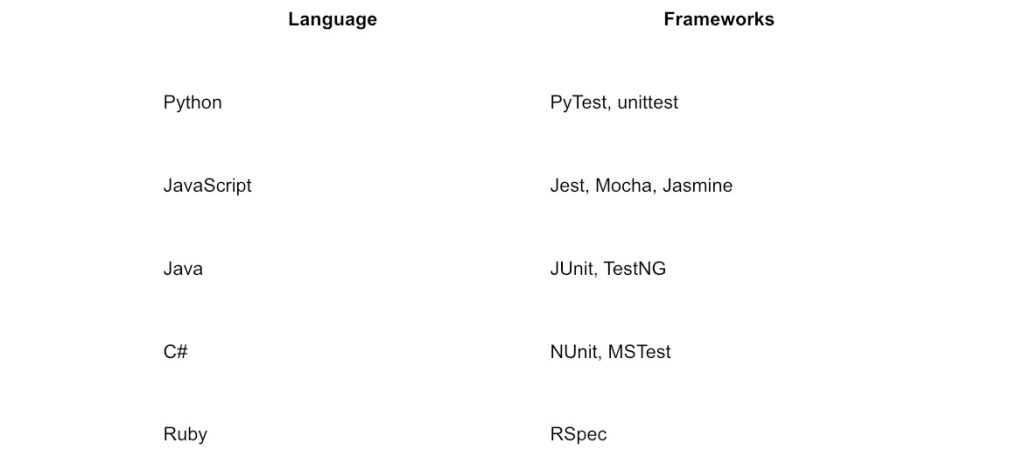
How This Helps You Stay Ahead of Automation:
As more companies shift toward automated testing pipelines, your ability to write clean, testable code becomes a superpower. TDD-trained developers are more efficient, more reliable, and more confident when deploying at scale — and that’s precisely the kind of talent automation can’t replicate.
3. Robotic Process Automation (RPA)
While CI/CD and TDD live mostly in the software development space, Robotic Process Automation (RPA) takes automation to a broader level — particularly in enterprise environments.
RPA tools mimic human actions to perform repetitive digital tasks across multiple systems. We’re talking about things like:
- Automatically processing invoices
- Copying data from spreadsheets into CRMs
- Handling simple customer service queries
- Moving files, emails, and documents between systems
Top RPA Tools to Explore:
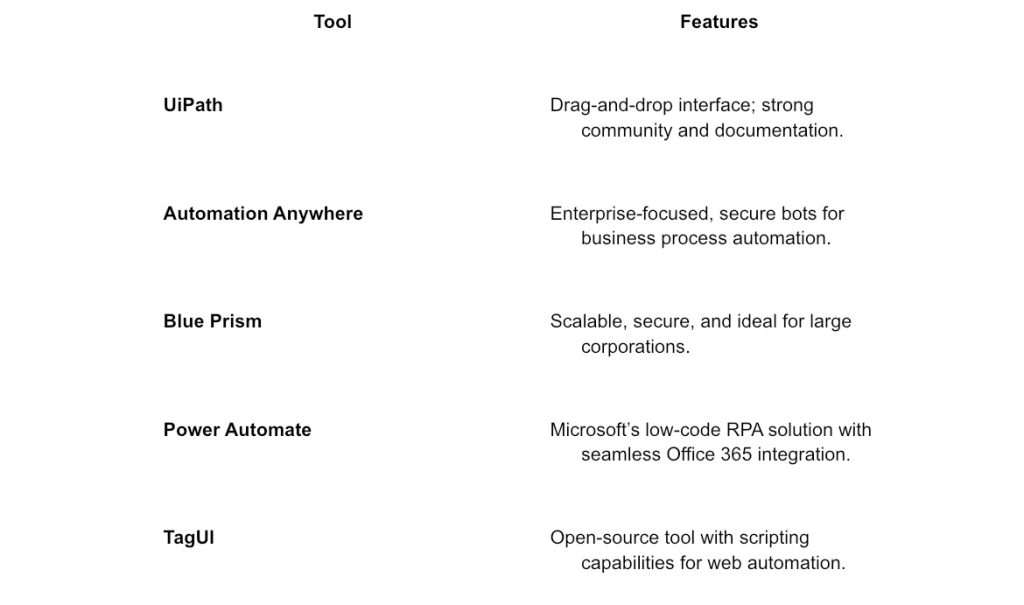
How This Helps You Stay Ahead of Automation:
Most businesses in Africa are still in the early stages of RPA adoption, which means opportunity. By learning to design and deploy automation bots, you’re positioning yourself as a forward-thinking tech professional who can save organizations time, money, and headaches.
You’re not just coding anymore, you’re automating workflows, optimizing business operations, and making real impact beyond just “writing code.”
Step 3: Cultivate a Problem-Solving Mindset
Let’s get something out of the way: automation is smart, but it’s not that smart.
Sure, it can process data faster than you can blink, generate code with shocking accuracy, and even respond to support tickets in multiple languages. But despite its capabilities, automation is fundamentally limited by one crucial thing, it doesn’t think. It calculates, replicates, and mimics. But it doesn’t truly understand. That’s where you come in.
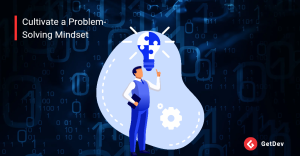
In the age of automation, the most valuable tech professionals aren’t the ones who can write the longest functions or memorize obscure syntax. They’re the ones who can solve problems creatively, think critically, and innovate under pressure. Automation can handle repetition, but real-world challenges? Those still need the human touch, especially in Africa’s dynamic and complex tech ecosystem.
Why a Problem-Solving Mindset Beats Raw Technical Skill
Think of it this way: a script can automate payroll processing, but it can’t decide how to restructure the system to adapt to new tax laws. An AI model can predict customer churn, but it can’t ask, “Why is this happening in the first place, and what innovative approach can we take to fix it?”
That gap between what’s automated and what’s possible is where human ingenuity shines. Tech professionals who excel at critical thinking, strategic planning, and creative innovation are the ones leading teams, shaping products, and defining the direction of the companies they work for.
In fact, global reports by Deloitte, McKinsey, and the World Economic Forum all point to one clear conclusion: problem-solving is one of the top skills that automation cannot replace and won’t anytime soon.
Key Traits to Build a Problem-Solving Mindset
Cultivating this mindset isn’t about becoming a genius overnight. It’s about developing habits that push you to approach challenges differently and consistently. Here’s what to work on:
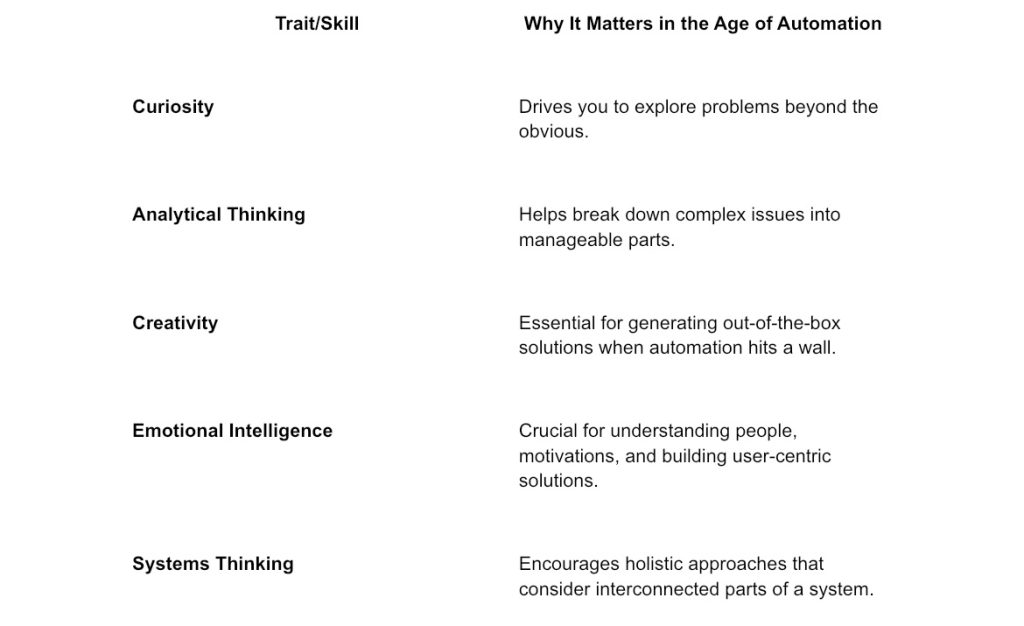
Real-World Applications in Africa’s Tech Ecosystem
Africa’s landscape is rich with unique challenges, from logistics issues in remote areas to fragmented payment systems, irregular electricity supply, and language diversity. These aren’t problems you can solve with copy-paste code or out-of-the-box software.
They require:
- Understanding local contexts
- Designing flexible, low-resource solutions
- Adapting existing technologies to suit niche needs
- Balancing technical efficiency with cultural and infrastructural realities
For example:
- A fintech app serving rural farmers needs offline functionality, intuitive UX in local dialects, and interoperability with basic feature phones, not just flashy automation.
- A healthtech startup may need to sync data between clinics where internet connectivity is unreliable. That’s not just a database issue, it’s a design problem, a workflow problem, and a human-centered problem.
These are areas where automation lags, but tech professionals with strong problem-solving skills thrive.
How to Practice Problem-Solving Daily
- Tackle Open-Ended Problems:
Participate in hackathons, coding challenges, or Kaggle competitions. Focus on real-life datasets or community issues that don’t have straightforward answers. - Build and Break Projects:
Don’t just follow tutorials; challenge yourself to rebuild them with modifications. Break the app, then fix it your own way. The process teaches more than you think. - Ask “Why?” and “What if?” Frequently:
When you encounter a bug, don’t just fix it, explore why it happened and what if you tried a different solution. This habit builds deeper understanding and better instincts. - Work on Cross-Functional Teams:
Collaborate with designers, marketers, and non-technical stakeholders. Understanding their perspectives improves your empathy, adaptability, and ability to solve multi-dimensional problems. - Write — Yes, Write:
Blog about your solutions, explain your thought process, or teach others. If you can explain a complex solution in plain language, you truly understand it.
Step 4: Build a Robust Professional Network
If you think success in tech is all about mastering programming languages or knowing the latest automation tools, think again. The truth is, your technical skills may get you in the door, but your network is what helps you stay in the room and in today’s fast-moving tech world, it’s your network that could be the difference between being an observer or a trailblazer in Africa’s tech ecosystem.
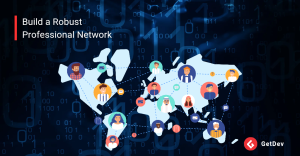
We all know the old adage: “It’s not what you know, it’s who you know.” Well, in the world of automation, AI, and machine learning, it’s what you know and who you know that can push you forward, especially in the evolving African tech scene. By building and nurturing strong connections, you not only get to share knowledge and opportunities but also gain valuable insights into new technologies and emerging trends that can help you stay ahead of automation.
Why Networking Matters More Than Ever
In the world of automation and AI, tech professionals often find themselves working across multiple disciplines. Whether you’re coding an AI-driven mobile app or designing an automated data pipeline, chances are you’ll need to collaborate with others, whether they’re designers, product managers, or fellow engineers. That’s where your professional network comes in.
Building a network isn’t just about exchanging business cards or adding people on LinkedIn. It’s about creating relationships that provide mutual value, insight, and opportunity. The more people you connect with, the more you’ll be exposed to different ways of thinking, diverse solutions to problems, and new opportunities that might not be publicly advertised.
Let’s not forget, networking also exposes you to the people who might one day become your partners, co-founders, clients, or collaborators. They can introduce you to key players in the industry, mentor you through complex problems, or even offer you a job when the right opportunity arises.
Where to Network: Local and International Communities
One of the best things about Africa’s tech scene is its growing sense of community. Tech enthusiasts in Nairobi, Lagos, Cape Town, and other African cities are becoming increasingly connected, both locally and globally. The beauty of today’s digital age is that you don’t have to be physically present to engage with others, but don’t underestimate the power of in-person connections either.
Here are the places and spaces you should be engaging with to build a diverse and impactful network:
1. Attend Meetups and Conferences
Conferences and meetups are invaluable for face-to-face connections. These events allow you to exchange ideas with fellow tech professionals, learn from industry leaders, and explore new trends firsthand.
Whether it’s a local DevOps meetup in Accra, a Machine Learning workshop in Nairobi, or a Global AI conference in Cape Town, these events offer access to some of the most important conversations in the field of automation. And don’t forget, attending local tech meetups in your city or town will often bring you closer to the people shaping your immediate community, which could open doors to collaborations, partnerships, and even new job opportunities.
Tech Conferences You Shouldn’t Miss:
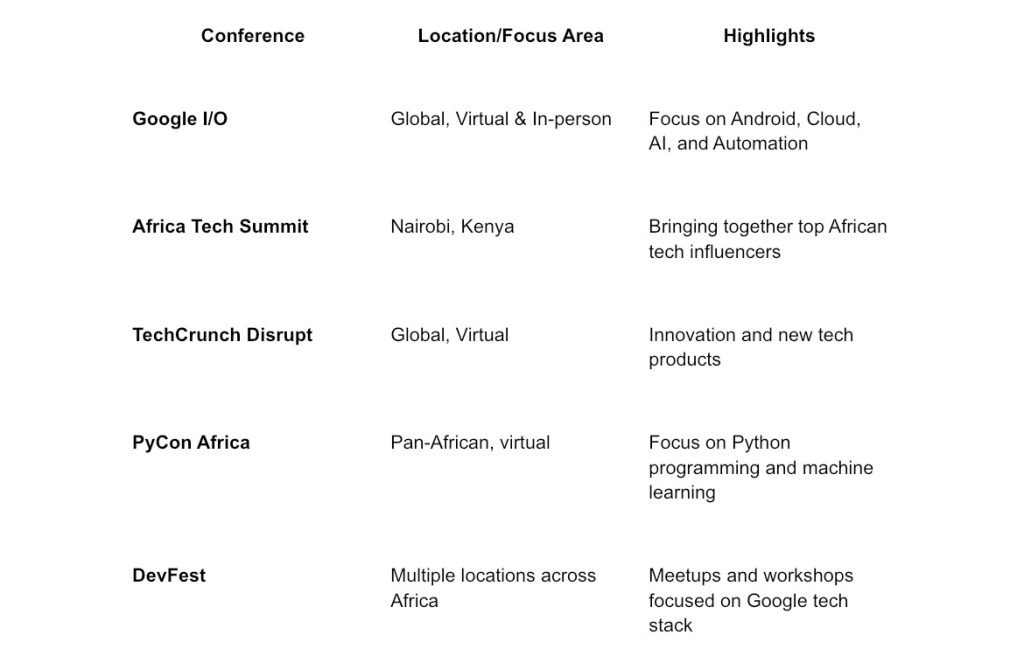
2. Participate in Hackathons
If you’re looking for an immersive way to sharpen your problem-solving skills, showcase your coding chops, and build your network simultaneously, hackathons are your best bet. These time-limited challenges are often centered around automation, AI, and ML, giving you the perfect platform to test your abilities in a competitive, collaborative environment.
Africa’s hackathon culture is growing, with events hosted by both local and international organizations. For instance, Google’s Developer Challenge and Microsoft’s Imagine Cup bring together thousands of developers, providing not only a challenge but the chance to make lifelong connections.
Why Hackathons Are Crucial for Networking:
- Teamwork: Hackathons are group-based events, so you’ll often collaborate with people who have diverse skills, from data scientists to UX/UI designers.
- Innovation: These events are often based on solving real-world problems with automation and AI, giving you practical experience and exposure to the latest technologies.
- Prizes and Recognition: Winning a hackathon or just participating in one can increase your visibility in the tech community, helping you attract clients or even job offers.
3. Collaborate on Open-Source Projects
Some of the best opportunities for networking and learning come from collaborating on open-source projects. Contributing to open-source not only gives you hands-on experience with automation frameworks and real-world applications but also helps you build a visible portfolio that others in the industry can see.
Platforms like GitHub, GitLab, and Bitbucket are where open-source communities thrive. From minor bug fixes to designing new features, open-source collaboration helps you connect with fellow tech enthusiasts and engineers from all over the globe.
How Open-Source Benefits Your Network:
- Collaborative Learning: Working on open-source projects exposes you to different coding styles and methods, sharpening your problem-solving skills.
- Visibility: Open-source contributions are often highly visible in the tech community. Building a strong presence on platforms like GitHub is an excellent way to show off your skills and attract potential collaborators.
- Global Connections: Through these projects, you can connect with others who share your passion for automation, from Africa and beyond. And who knows? One of these connections might lead to your next career opportunity or business venture.
The Power of Social Media and Online Communities
Beyond in-person events, social media platforms and online communities have revolutionized how professionals network. LinkedIn, Twitter, and Slack channels are where some of the most influential tech professionals share insights, discuss trends, and even post job openings.
Building a network online is more than just connecting on LinkedIn or tweeting out your latest GitHub project. To truly benefit from these platforms, you need to be active, comment on posts, share resources, and engage in meaningful discussions. Platforms like Stack Overflow, Reddit, and Dev.to also host vibrant tech communities, offering a space for you to ask questions, help others, and stay informed.
Step 5: Contribute to Africa’s Tech Ecosystem
In a world where automation is reshaping the tech industry, it’s easy to focus solely on your own development and career. But there’s a bigger picture. As a software developer, AI engineer, or tech enthusiast, you hold the key to Africa’s evolving tech ecosystem. What you contribute today will define the landscape of tomorrow and not just for you, but for an entire generation of tech professionals.

Contributing to Africa’s tech ecosystem means actively participating in its growth, sharing knowledge, mentoring the next wave of innovators, and advocating for the adoption of emerging technologies like automation. It’s not just about what you can achieve individually; it’s about how you can elevate the entire community.
But how can you do that in a meaningful way? In this step, we’ll explore ways you can share your expertise, guide others, and advocate for the future of tech in Africa.
1. Share Your Knowledge Through Blogs, Tutorials, and Articles
There’s an old saying: “Knowledge is power”. But what if that knowledge is locked away? Sharing your expertise with others is one of the most impactful ways to contribute to Africa’s tech ecosystem. Writing blogs, creating tutorials, or even posting thought-provoking articles on automation technologies allows you to pass on what you’ve learned and empower others in the process.
For instance, you could write a blog post about how to get started with Robotic Process Automation (RPA) in a small business context, explaining how automation can save time and reduce operational costs. Or, you could create a tutorial on how AI is revolutionizing local industries like agriculture or healthcare in Africa, providing practical insights for others interested in these fields.
Why Blogging and Writing Matters:
- Empowerment through Education: When you share your experiences, you help other tech professionals and tech newbies in Africa avoid common pitfalls and accelerate their learning.
- Visibility and Influence: As you share more of your insights, you establish yourself as an authority in your field. Over time, this helps you become a thought leader, and people will look to you for guidance on automation and other emerging technologies.
- Global Reach: With the internet, you’re not just educating your local community, your posts, tutorials, and articles can be accessed globally, spreading knowledge far and wide.
Platforms to Get Started:
- Dev.to: Share articles and tutorials with a dedicated tech community.
- Medium: Publish your long-form content to reach a broader audience.
- LinkedIn: Write short posts or long-form articles on emerging tech trends and automation.
- GitHub: Share open-source projects and documentation for automation tools.
2. Mentor Aspiring Tech Enthusiasts
The value of mentorship can’t be overstated. It’s one thing to learn through reading books and watching tutorials, but it’s another to have someone guide you through the nuances, help you tackle challenges, and provide career advice. In Africa’s rapidly expanding tech sector, there’s a significant demand for mentors who can help shape the next generation of tech professionals.
As an experienced AI or ML engineer, you have valuable knowledge that can empower others to take their skills to the next level. By mentoring tech enthusiasts or students looking to break into the industry, you’re creating a cycle of learning that will continue to elevate the entire community.
Why Mentoring Is Vital:
- Bridging the Knowledge Gap: Many tech newbies in Africa lack the resources or guidance to succeed in the tech industry. Your expertise can help them navigate the challenges they face.
- Building Relationships: Mentorship creates strong, lasting connections within the tech community. You’ll not only help others but also learn from their fresh perspectives and ideas.
- Expanding Impact: By mentoring, you multiply your influence. Your mentees will go on to mentor others, continuing the cycle of knowledge sharing and growth in Africa’s tech ecosystem.
Ways to Get Involved in Mentorship:
- Local Universities and Bootcamps: Partner with universities or tech bootcamps to guide students through their AIor automation projects.
- Online Mentorship Programs: Platforms like CodeMentor, Udemy, and LinkedIn allow you to offer mentorship virtually, making your expertise accessible to anyone with an internet connection.
- Hackathons and Competitions: Offer guidance during hackathons, providing advice on problem-solving, AI, and automation techniques.
3. Advocate for the Adoption of Automation Technologies in Local Industries
One of the most significant ways to contribute to Africa’s tech ecosystem is by advocating for the adoption of automation technologies within local industries. Automation isn’t just a buzzword, it’s a solution to many challenges that African businesses face, from improving operational efficiency to tackling the skills gap.
Whether it’s advocating for Robotic Process Automation (RPA) in financial institutions or promoting AI-driven solutions in agriculture, there’s a growing need for experts who can demonstrate how automation can enhance productivity, reduce costs, and drive innovation.
Why Advocacy Matters:
- Increasing Awareness: Many businesses, especially small and medium-sized enterprises (SMEs), may not understand the potential of automation technologies. By advocating for automation, you help them see its value and encourage them to invest in the right tools.
- Shaping Policy and Strategy: As automation becomes more widespread, it’s essential to push for policies that support its implementation. Your voice can help shape government and industry strategies that accelerate Africa’s automation adoption.
- Boosting Africa’s Competitiveness: By encouraging the use of AI, machine learning, and RPA, you help local industries stay competitive on a global scale. African tech professionals can play a pivotal role in transforming the continent’s economy.
How to Advocate for Automation:
- Host Webinars or Talks: Use platforms like YouTube or Zoom to host webinars and live sessions on the benefits of automation in different industries.
- Collaborate with Industry Leaders: Partner with businesses, startups, and government organizations to discuss how automation can solve real-world problems in your region.
- Create Educational Content: Publish case studies, white papers, or guides on how automation can be implemented in local industries, offering actionable insights.
4. Build and Contribute to Open-Source Projects
Finally, contributing to open-source projects allows you to directly participate in the development of automation toolsand frameworks that benefit everyone. Open-source software is central to innovation, providing free access to powerful tools that developers around the world can use, modify, and improve.
By contributing to open-source projects, you’re not just building your skills, you’re giving back to the community. Plus, it’s a great way to network with other tech professionals, gain visibility, and be part of global conversations about automation and AI.
Step 6: Stay Agile and Adapt to Change
The tech industry is like a fast-moving river — one moment you’re navigating calm waters, and the next, you’re dealing with rapids. In a world dominated by automation, AI, and machine learning, change is the only constant. This constant evolution of technology demands that tech professionals not only stay updated on the latest trends but also develop the ability to quickly pivot and adapt.

In Africa’s growing tech ecosystem, the ability to stay agile has never been more critical. As the global tech scene shifts with new innovations, tools, and frameworks, staying ahead means embracing agility in your work processes, mindset, and career strategy. This is particularly true for software developers, AI engineers, and ML specialists who must be prepared for continual shifts in both technology and business needs.
So, how do you maintain this flexibility while building a successful career in an ever-changing landscape? This step will outline the importance of adopting agile methodologies, the value of continuously reassessing your skills, and the need to regularly adjust your strategies to keep pace with new developments in automation and beyond.
1. Adopt Agile Methodologies for Efficient Development
One of the most important ways to stay agile in tech is by embracing agile methodologies. Agile is a set of principles for software development that emphasizes flexibility, collaboration, and customer-centric iterations over rigid planning and structure. It allows you to be responsive, rather than reactive, to changes in project scope, market needs, and technology trends.
For software developers and AI engineers working in the automation space, agility is essential for responding to the ever-changing demands of automation projects. Agile practices, such as Scrum and Kanban, allow you to break down large projects into smaller, more manageable chunks. This makes it easier to introduce incremental changes, adapt to new requirements, and fine-tune your processes without disrupting the entire project flow.
Benefits of Agile Methodologies:
- Flexibility: Agile helps you quickly respond to shifts in client needs, tech advancements, or project requirements. In an industry dominated by automation, this is crucial to avoid stagnation.
- Faster Delivery: By breaking tasks into smaller units and iterating quickly, you can deliver more value faster, which is essential in the fast-paced world of tech in Africa.
- Collaboration and Communication: Agile fosters teamwork, where developers, designers, and product managers can collaborate in real-time. This is especially important when integrating new automation tools into your workflow.
Agile Practices You Can Implement:
- Daily Standups: Keep the team aligned and make quick adjustments based on any changes or new developments.
- Sprints: Work in short bursts (typically 1-2 weeks) to quickly complete tasks, with regular evaluations to assess progress.
- Retrospectives: After each sprint, conduct a review to reflect on what worked and what didn’t, ensuring continuous improvement.
By incorporating agile methodologies into your work, you can stay responsive to changes in technology, making it easier to adopt and integrate new automation tools or pivot to new projects as industry demands evolve.
2. Regularly Assess and Adjust Your Skills
Just as automation continuously evolves, so too must your skills. In an industry where tools and technologies can become obsolete in a matter of months, relying on yesterday’s knowledge won’t keep you ahead of the curve. You need to constantly assess your technical skill set and be willing to learn and adapt.
For instance, in AI and machine learning, new algorithms, frameworks, and techniques emerge rapidly. If you’re not constantly upskilling and adapting, you’ll miss out on the opportunities that come with these innovations. Regularly assessing your skills allows you to spot knowledge gaps and actively seek solutions.
Why Continuous Skill Assessment Matters:
- Stay Relevant: By keeping your skills updated, you ensure that you’re always equipped to handle the latest technologies and methodologies in automation.
- Competitive Edge: In a fast-paced tech environment, those who are proactive about upgrading their skills have the edge over others who wait for change to happen.
- Adaptability: Continuous learning helps you become more adaptable to new tools and technologies, whether it’s mastering a new automation framework or keeping up with the latest developments in AI.
How to Assess and Improve Your Skills:
- Take Online Courses: Platforms like Coursera, edX, and Udacity offer specialized courses in emerging technologies such as AI, ML, and automation.
- Participate in Workshops and Meetups: These provide hands-on learning experiences and the opportunity to connect with industry leaders.
- Engage in Peer Reviews: Peer-to-peer learning is an excellent way to assess your strengths and weaknesses while gaining insights into best practices.
- Attend Webinars and Conferences: Stay updated on new trends, such as RPA, machine learning models, or cloud automation technologies, and understand how they’re being implemented globally.
By keeping track of emerging trends and upskilling yourself regularly, you position yourself as a leader in the automation space, ready to take on new challenges as the industry evolves.
3. Be Open to Change and Continuous Improvement
The tech industry’s rapid changes can be daunting, but they also present incredible opportunities. Whether it’s a new AI-powered automation tool or a shift towards cloud-based infrastructure, staying agile means embracing change rather than fearing it. Agility in this context means cultivating a mindset that allows you to adapt to new situations and evolveas the industry moves forward.
It’s not just about adopting new technologies but also improving how you work. For example, consider automating parts of your workflow that are repetitive or time-consuming, enabling you to focus on more complex tasks that require human ingenuity. Automation tools themselves evolve rapidly, and as a tech professional, you must be ready to adapt by exploring new automation frameworks and platforms.
How to Embrace Change:
- Experiment and Innovate: Don’t be afraid to try new technologies and workflows. If a new automation toolcomes out, explore how it can improve your development process.
- Iterate and Reflect: Just as you assess your skills, regularly evaluate your workflows and team dynamics. Ask, “What can we improve, and how can we make our process more agile?”
- Encourage Feedback: Build a culture of feedback within your team. Regularly solicit input from peers and mentors to continuously refine your methods.
4. Foster an Agile Mindset in Your Team or Organization
If you work within a team or lead a team, one of the best ways to stay agile is by promoting an agile mindset throughout your organization. This means embracing flexibility, prioritizing continuous improvement, and making collaboration a cornerstone of every project.
In an Africa-based tech company, where the environment is often dynamic and full of opportunity, fostering an agile mindset can help you respond more effectively to both challenges and emerging opportunities in automation.
Step 7: Address Infrastructure Challenges
Africa’s tech ecosystem is growing at an unprecedented rate, but with rapid growth comes the need to confront the pressing infrastructure challenges that threaten to hinder the widespread adoption of automation. While the benefits of automation, from increased productivity to enhanced efficiency, are clear, technical constraints, particularly unreliable power supply and inadequate telecommunications infrastructure continue to pose significant barriers in many regions across the continent.

For software developers, AI engineers, and tech professionals across Africa, these challenges are not just obstacles; they are call-to-action moments. If automation is to take root and flourish in Africa, it’s imperative that infrastructure issues are addressed head-on. From unreliable electricity grids to poor internet connectivity, these problems can stifle innovation, slow down development processes, and inhibit the ability to integrate advanced AI, machine learning (ML), and robotic process automation (RPA) tools effectively.
In this step, we’ll explore how to recognize and navigate infrastructure challenges, advocate for improvements, and work toward creating an environment conducive to seamless automation adoption in Africa.
1. Identify Key Infrastructure Challenges
The first step in overcoming infrastructure limitations is understanding the specific technical constraints that exist in your region. Infrastructure issues in Africa are not uniform, and different regions face different challenges. By pinpointing these problems, you can better navigate them and advocate for improvements.
Here are the most common infrastructure challenges facing automation adoption in Africa:
1.1 Unreliable Power Supply
In many parts of Africa, inconsistent or unreliable electricity is a significant challenge. Power outages or blackouts can bring automation projects to a halt, affecting everything from AI model training to software development and deployment.
- Power Supply Issues: Frequent interruptions in power supply can significantly delay the work process, especially in industries that require continuous computing or access to cloud-based platforms.
- Energy Infrastructure Gaps: While some urban areas are connected to the national grid, remote areas often rely on alternative power sources like generators, which are not always sustainable or cost-effective.
1.2 Inadequate Telecommunications and Internet Connectivity
While many African countries are improving their internet access, broadband speeds and telecommunications infrastructure still lag behind global standards in some regions. Without fast and reliable internet, adopting cloud-based automation tools, accessing machine learning libraries, and collaborating on global platforms becomes exceedingly difficult.
- Slow Internet Speeds: Slow speeds can hamper the use of online tools for automation and prevent real-time collaboration for international projects.
- Data Accessibility: Poor data connectivity can make it challenging to access the large datasets required for AI and ML training, as well as impeding effective use of cloud services.
1.3 Limited Access to High-Performance Computing (HPC)
Some automation technologies require powerful computing resources to function optimally. High-performance computing infrastructure, including advanced GPUs and specialized hardware for running AI models, may not always be readily available in some African regions. This limitation can delay innovation and the integration of automation solutions in local businesses.
2. Advocate for Infrastructure Improvements
While some of these issues might feel insurmountable, advocacy can play a vital role in addressing infrastructure challenges. As a tech professional in Africa, you can use your platform to highlight these challenges, raise awareness, and push for systemic changes that improve power supply, telecommunications, and cloud infrastructure.
Here are several ways you can advocate for infrastructure improvements:
2.1 Engage with Policymakers and Industry Leaders
Collaboration with policymakers and industry leaders is essential in advocating for better infrastructure. In many African nations, governments and private-sector companies are already working to modernize energy and telecom infrastructure, but they need to hear from the tech community about how these challenges directly affect innovation and automation.
- Public-Private Partnerships: Encourage tech startups and corporate giants to collaborate with governments to improve power reliability and broadband connectivity in underserved areas.
- Policy Engagement: Engage in public forums, technology conferences, or even write op-eds and blog posts to highlight the need for stronger infrastructure to support the growing tech scene in Africa.
2.2 Support Renewable Energy Initiatives
Renewable energy can be a solution to Africa’s unreliable power supply. By advocating for and supporting the use of solar, wind, and hydropower technologies, you can help mitigate the effects of power outages and reduce reliance on expensive fossil fuels. Many regions in Africa have abundant natural resources, making renewable energy a viable long-term solution.
- Green Tech Innovations: Join or initiate green tech initiatives that promote the adoption of solar energy or microgrids to power tech hubs, data centers, and offices that rely on continuous power for automation and development work.
- Tech Solutions for Sustainability: Leverage machine learning and AI to develop energy-efficient solutions that optimize the use of renewable energy in urban and rural areas.
2.3 Build and Join Tech Community Advocacy Groups
In many African countries, local tech communities are taking the lead in advocating for infrastructure development. By joining these communities or creating your own, you can help build a collective voice that calls for infrastructure improvements.
- Tech-Advocacy Forums: Organize online forums or local meetups where AI engineers, ML developers, and other tech professionals can come together to discuss infrastructure challenges and potential solutions.
- Collaborate on Research: Work with universities, research institutions, and industry leaders to create research reports and case studies that demonstrate the economic impact of improved infrastructure for automation adoption.
3. Mitigate Infrastructure Limitations Where Possible
While advocating for systemic change is important, it’s also crucial to find creative ways to work around the existing infrastructure limitations in the short term. As software developers, AI engineers, and automation specialists, you can implement workarounds to mitigate the impact of these challenges.
3.1 Leverage Offline Solutions and Edge Computing
In areas with unreliable internet or power supply, you can develop or implement offline solutions or utilize edge computing. Edge computing allows data to be processed locally on devices rather than relying on central servers, reducing the reliance on a constant internet connection.
- Edge AI Models: Develop and deploy AI models that work on local devices without needing continuous cloud access. This reduces dependency on constant connectivity.
- Offline Tools: For automation tasks that don’t require real-time updates, implement offline solutions that can function without continuous internet access, allowing tasks to be completed regardless of power or connectivity issues.
3.2 Use Low-Bandwidth Tools for Collaboration
In regions where internet speeds are slow, opting for low-bandwidth tools for collaboration and development can help overcome connectivity issues.
- Lightweight Platforms: Use lightweight tools like Slack and Trello, which are less resource-intensive and can still enable remote collaboration even with slower internet connections.
- Offline Development: In instances where connectivity is particularly problematic, focus on offline development for AI and automation projects. You can always upload data or code to the cloud once connectivity improves.
4. Invest in Localized Solutions
Many African tech hubs are creating innovative solutions that are tailored to local infrastructure challenges. By investing in or supporting these localized efforts, you can contribute to the development of technologies that help address the specific needs of African markets.
- Local Data Centers: Support the growth of local data centers to ensure that businesses and developers have access to low-latency cloud services without relying on international cloud providers, which may be hindered by slow internet connections.
- Localized Tech Startups: Partner with local tech startups that are focused on solving infrastructure issues, such as energy-efficient technologies and reliable telecommunication solutions.
Conclusion: Powering Africa’s Automation Future
While Africa’s infrastructure challenges undoubtedly present significant obstacles to the widespread adoption of automation, they are by no means insurmountable. These hurdles may seem daunting, but they also offer a unique opportunity for tech professionals in Africa to become part of the solution, driving innovation and ensuring that the continent doesn’t just catch up to global trends but leads the charge in automation. By understanding the constraints, advocating for much-needed reforms, and thinking creatively to work around these limitations, developers, AI engineers, and tech enthusiasts can play an active role in accelerating the continent’s transition to an automated future.
Addressing key infrastructure challenges, such as inconsistent power supply, unreliable telecommunications networks, and limited access to high-performance computing is critical for creating an environment in which advanced AI, machine learning (ML), and robotic process automation (RPA) can flourish. As these technologies become more integrated into every aspect of business and daily life, tech professionals in Africa will need to step up and contribute not only by mastering the latest automation tools and frameworks but also by helping to build and improve the infrastructure that makes these technologies feasible.
The future of automation in Africa is not only about adopting the most cutting-edge technologies; it’s about laying the groundwork for their successful implementation through robust infrastructure that empowers both individuals and industries. Africa’s automation journey is inherently tied to its ability to overcome infrastructure challenges and harness the continent’s immense tech potential.